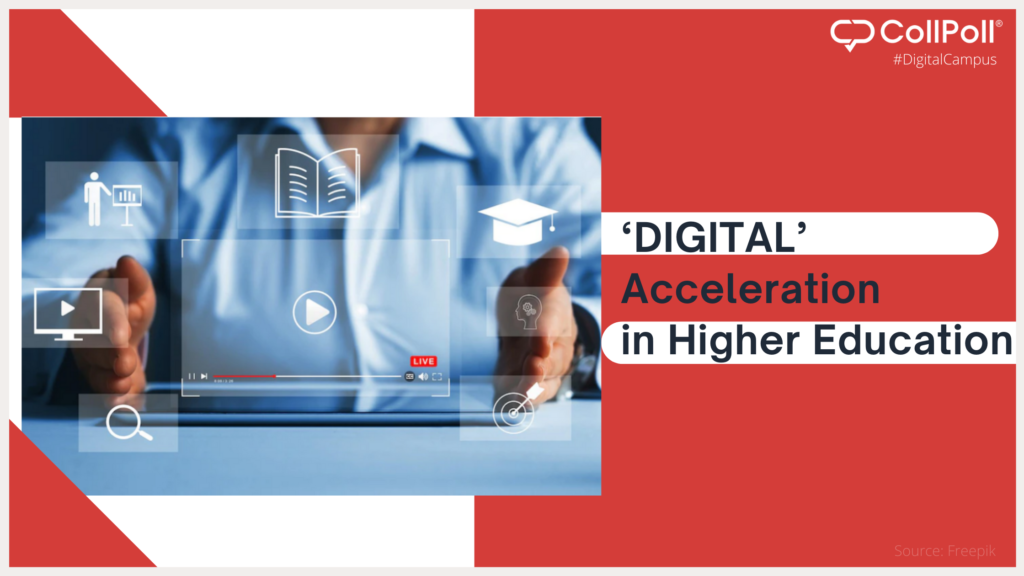Can academic institutions endure without adapting new learning technologies? Can higher educational institutions (HEI) or universities thrive by adopting new technologies without shifting their organizational configuration and processes? Can universities survive the digital age without investing in technology? Questions like these have been unchanged, unanswered, and partially unattempted. With the higher education industry fetching more competitive, all organizations have enforced many of them to prefer strategies that boost organizational digital journey in terms of effectiveness and efficiency. It is evident that we cannot return to the world as before. The pandemic has radically reshaped our life and compelled almost each one of us to go digital.
Every higher education institution has a unique set of priorities. With the present rapid rate of change, university leadership teams need to deliberate how digital technologies affect their future. They need to think about a lot of strategic issues. To help senior leadership teams, governing bodies and academic councils make the best options for universities, this article, therefore, discusses concerns and attempts solutions. For some institutions, it provides a unique proposition and helps them map out a future strategy based on a digitally enabled offering. For others, it helps improve current methods with significant enhancements to student learning and experience. Others can consider re-evaluating their current tactics in light of the pandemic’s lessons. Doing nothing will not be an option in the intensely competitive higher education market, where expectations from stakeholders, including governments, as well as those of students and potential recruiters, are shifting. Let’s discuss the potential drivers for accelerating digital adoption success.
#1 Towards World Class Education, experience, and competitiveness
Integration of new technologies, tools, and modes of working with much faster adoption would surely boost confidence in addressing the challenges of digitalization with the right strategic approach. It also assists universities in scaling in the global higher education market to meet international students’ needs. Having a long-term digital strategy in place improves the capabilities to deal with the future unforeseen crisis by providing them with a roadmap for action and expediting teaching-learning facilitation. These actions would ensure and be ready to switch offline/online synchronous or asynchronous as needed with a high-quality experience.
#2 Paradigm shift – Phygital Campus (Brick and Click)
The emergence of “self-funded” and even “for-profit” higher education institutions shows that competition for students, qualified staff, and a share of the grant for research and publishing is intense. HEIs are pushing hard to encourage the intellectual capital gain of students and staff members. Even ranking frameworks assist HEIs in setting a benchmark to work to achieve institutional progression with great opportunities for national and international collaborations. While hitting the reset button after the pandemic, physical reporting of students on campuses was reintroduced. Can we formulate a better, admirable, and sustainable education model that blends physical and digital experiences? Can we have a phygital way of learning?
#3 It starts at the Top – Leading Change
The success of the digital transformation and strategy depends on a culture change, which must start at the top. Many senior university leaders would benefit from actively building their awareness of the domains in digital technologies because of the rapid rate of change. Their decision-making capacity will be influenced by confidence and expertise in academics. The adoption of digital is not only limited to online delivery or learning management systems in place but also far beyond that. To place digital in the forefront of what we do, there are many things we must do. The power of technology must be emphasized, both in terms of what it adds to student learning, how it brings value and how we provide our services.
#4 Role of Teachers
The success of the digital transformation journey depends on how ready and capable your teachers and education facilitators are to put it into action. When faced with no other option than to use digital technology, educators have proven time and time again that they are capable of moving mountains. Yes! HEIs must meticulously evaluate teachers’ ICT skills and competence to keep digital momentum going. Success is guaranteed by finding the perfect balance between vision, mission and culture, benchmarking the same thereby. Identifying digital champions across HEIs who are excited about digital technology and rewarding them with incentives or funding assistance would surely accelerate value creation.
#5 Technology as an integral part of student’s journey
To the fullest ability of digital technology, universities can fundamentally alter how staff members and students interact with one another by using it strategically. The use of digital must be acknowledged as a strategic asset and not a liability. It proves to be a means of advancing the university’s mission and goals. Usually, digital solutions are deployed on ad hoc, with little support, and are only perceived as tools or point systems within universities. Kind attention and resources must be dedicated to it for its successful adoption. The adoption of technology is going to be a game-changer. The use of technology in course instruction, curriculum design, delivery, and engagement are inevitable transition in higher education.
The accomplishment of digital transformation is much subjective and biased for student engagement and experience. Connecting students with the right content at the right time and context matters the most in today’s educational model. Ultimately, students can help a higher education institution meet its vision and mission today and well into the future. There is no one-size-fit-all approach to digital transformation/adoption because each organization’s particular vision and core values must be considered when choosing its digital strategy, techniques, and technology. A strong leadership in higher education can help identify and fast-track the adoption of digital transformation drivers play a crucial role too. Teachers and education facilitators have already proved that nothing can stop them from imparting knowledge, let’s give them the right tools through technology and help them do their jobs even better!
In a nutshell, long-term success depends on the adoption of digital processes throughout the student lifecycle, from prospects to alumni with great experiential learning. Even while there is still plenty to do and it is still early, it is high time to start thinking about what a better future model would entail. The future university’s foundation will be built on our current digital tools. Let’s keep the momentum going. Keep learning, keep reflecting and keep rocking!
To know more about the adoption of technology in higher education, reach out to him on his LinkedIn Account: Suraj Bhoyar or via email: suraj.bhoyar@collpoll.com!







